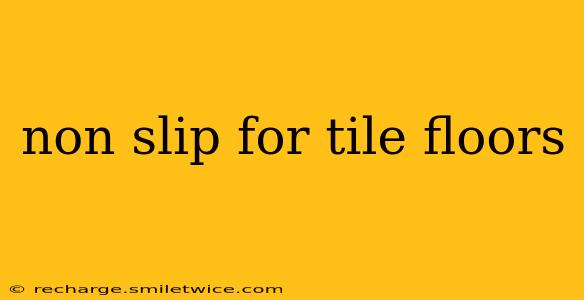Tile floors offer a sleek and stylish look for any home, but their smooth surface can pose a safety hazard, especially for children and the elderly. Slips and falls are a serious concern, making non-slip solutions for tile floors a crucial consideration for homeowners. This comprehensive guide explores various options to enhance safety without compromising aesthetic appeal. We'll delve into the best methods, factors to consider, and answer common questions to help you choose the perfect non-slip solution for your tile floors.
What are the Best Non-Slip Options for Tile Floors?
Several effective methods can significantly reduce the risk of slipping on tile floors. The best option depends on your budget, the type of tile, and your personal preferences. Here are some of the most popular and effective choices:
-
Non-Slip Mats and Rugs: These are a quick and easy solution, ideal for high-traffic areas like entryways and kitchens. Look for rugs with a rubber backing for superior grip. Consider the material and thickness for comfort and durability. Larger rugs can help cover a significant portion of the floor, while smaller mats can be strategically placed near sinks and showers.
-
Non-Slip Strips and Tapes: For targeted areas like stair treads or shower floors, non-slip strips and tapes offer a practical and affordable solution. These come in various materials and colors, allowing for customization. Ensure they are appropriately rated for the type of tile and the level of moisture exposure.
-
Non-Slip Coatings and Sealants: These are applied directly to the tile surface, creating a textured finish that improves traction. This method provides a permanent solution, but requires more effort in application. It's crucial to choose a coating compatible with your tile material to prevent damage or discoloration.
-
Anti-Slip Tile Treatment: Some manufacturers offer specialized treatments specifically designed to enhance the slip resistance of tiles. This is often a professional service that provides a long-lasting, effective solution.
-
Replacing Tiles with Non-Slip Alternatives: If you're remodeling or installing new tile, consider choosing tiles with a higher coefficient of friction (COF). Many manufacturers produce tiles specifically designed with non-slip properties.
What is the Coefficient of Friction (COF) and Why Does it Matter?
The coefficient of friction (COF) is a crucial factor in determining the slip resistance of a surface. It measures the amount of friction between two surfaces in contact. A higher COF indicates better slip resistance. When choosing tiles or non-slip treatments, check the COF rating to ensure it meets the safety standards for your specific needs. Look for tiles or treatments with a high COF, especially in wet areas like bathrooms and kitchens.
How Can I Make My Tile Floors Less Slippery?
Besides the methods mentioned above, there are other simple steps you can take to reduce the slipperiness of your tile floors:
Regularly Clean Your Floors
Regular cleaning helps remove dirt, grime, and other substances that can contribute to slippery surfaces. Always use appropriate cleaning products to avoid leaving behind residue.
Use Microfiber Mops and Cloths
Microfiber materials are highly effective at cleaning and absorbing moisture, helping to prevent slippery floors.
Avoid Using Too Much Water or Cleaning Solution
Excess water or cleaning solution can create a slippery film on tile surfaces. Always use the recommended amount and ensure proper drying after cleaning.
What are the Best Non-Slip Products for Bathrooms?
Bathrooms present unique challenges due to high moisture levels. In this area, non-slip mats, tapes designed for wet environments, and non-slip coatings specifically formulated for damp conditions are the best options. Consider using textured tiles or incorporating strategically placed grab bars for additional safety.
Are there DIY Non-Slip Solutions for Tile Floors?
While professional solutions offer the best long-term results, some DIY methods can provide temporary improvements. For example, applying a thin layer of car wax (appropriately designed for floors) can provide a slightly improved grip. However, remember that these DIY methods are generally not as effective or long-lasting as professionally applied solutions.
Choosing the Right Non-Slip Solution: What Factors Should I Consider?
Choosing the right solution requires careful consideration of several factors:
-
Location: The area of your home will determine the type of solution most appropriate. High-traffic areas might need more durable options.
-
Budget: Solutions range from affordable mats to more expensive professional treatments. Set a budget before starting your search.
-
Aesthetic Preferences: Choose a solution that complements your existing decor.
-
Maintenance: Some solutions require more maintenance than others.
-
Tile Type: The material of your tiles will influence the suitability of certain non-slip solutions.
By carefully considering these factors and exploring the various options available, you can significantly improve the safety of your tile floors without sacrificing style. Prioritizing safety in your home is an investment in the well-being of your family and yourself.
